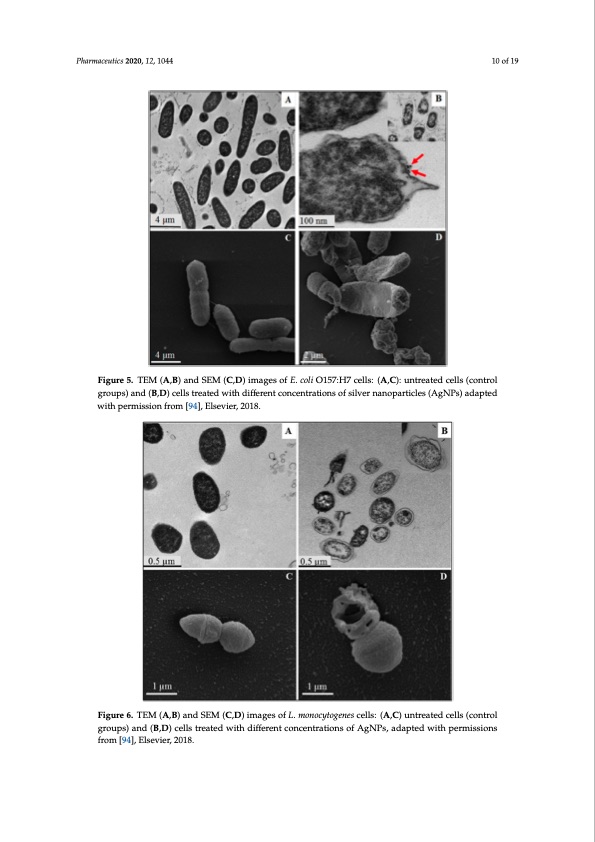
PDF Publication Title:
Text from PDF Page: 010
inhibition zone of 20 mm. This suggests that the antibacterial potency of the AgNPs might be related to the membrane structure of the bacteria. Electron spin spectroscopy (ESR) was used to investigate if the free radical production from AgNPs formed at pH 7 after 48 h of reaction time is related to the antimicrobial activity. The results showed that the growth inhibition was due to the formation of free radical species from the surface of AgNPs, which altered the permeability of the outer membrane and Pharmaceutics 2020, 12, 1044 10 of 19 inactivated the respiratory function of the bacteria. Figure 5. TEM (A,B) and SEM (C,D) images of E. coli O157::H7 cells: (A,C): untreated cells (control groups) and (B,D) cells treated with difffferent concentrations of silver nanoparticles (AgNPs) adapted Pharmaceutics 2020, 12, x FOR PEER REVIEW 11 of 20 with permission from [94],, Ellseviier,,201188.. Soo-Hwan et al. [107] showed that the mechanism of bactericidal effect of AgNPs against S. aureus and E. coli was by the production of ROS due to increased membrane permeability and the inactivation of lactate dehydrogenase, which eventually led to protein breaks. More protein leakage occurred in the membrane of E. coli compared with that S. aureus. This observed difference was possibly attributed to the thickness of the peptidoglycan layer of S. aureus [107]. Gomaa [108] corroborated these results in the study of the bactericidal mechanism of AgNPs with respect to S. aureus and E. coli. The growth curve was measured, followed by an estimation of the protein and reducing sugar leakage. Furthermore, lethal ROS and respiratory chain dehydrogenase activity were evaluated. The study showed that 50 mg/mL AgNPs completely inhibited the growth of bacterial cells and damaged the bacterial membrane permeability, depressing the activity of some membranous enzymes, which eventually led to bacteria cell death. In this study, Dye 20, 70- dichlorofluorescein diacetate (DCFH-DA) was used to measure the ROS. It was observed that after 6 h incubation of the E. coli and S. aureus with AgNPs, there was a significant increase in ROS production however, this was not observed in the control groups. Significantly, AgNPs are stress inducers for bacteria. Figure 6. TEM (A,B) and SEM (C,D) images of L. monocytogenes cells: (A,C) untreated cells (control Figure 6. TEM (A,B) and SEM (C,D) images of L. monocytogenes cells: (A,C) untreated cells (control groups) and (B,D) cells treated with different concentrations of AgNPs, adapted with permissions groups) and (B,D) cells treated with different concentrations of AgNPs, adapted with permissions from [94], Elsevier, 2018. from [94], Elsevier, 2018. Qayyum et al. [109] expanded their study to Gram negative (K. pneumoniae, P. aeruginosa and E. coli) and Gram positive (S. mutans and S. aureus) strains. The results showed that green AgNPs produced ROS after 4 h of incubation with the bacterial cells. It was observed that increased contact time of the AgNPs with the bacterial cells led to increased production of the ROS. Additionally, the quantity of ROS increased several times compared to that of the control group for both Gram positive and Gram negative bacteria. However, more ROS production was observed in the treated GramPDF Image | Bactericidal Antibacterial Mechanism of Plant Nanoparticles

PDF Search Title:
Bactericidal Antibacterial Mechanism of Plant NanoparticlesOriginal File Name Searched:
pharmaceutics-12-01044-v2.pdfDIY PDF Search: Google It | Yahoo | Bing
Turbine and System Plans CAD CAM: Special for this month, any plans are $10,000 for complete Cad/Cam blueprints. License is for one build. Try before you buy a production license. More Info
Waste Heat Power Technology: Organic Rankine Cycle uses waste heat to make electricity, shaft horsepower and cooling. More Info
All Turbine and System Products: Infinity Turbine ORD systems, turbine generator sets, build plans and more to use your waste heat from 30C to 100C. More Info
CO2 Phase Change Demonstrator: CO2 goes supercritical at 30 C. This is a experimental platform which you can use to demonstrate phase change with low heat. Includes integration area for small CO2 turbine, static generator, and more. This can also be used for a GTL Gas to Liquids experimental platform. More Info
Introducing the Infinity Turbine Products Infinity Turbine develops and builds systems for making power from waste heat. It also is working on innovative strategies for storing, making, and deploying energy. More Info
Need Strategy? Use our Consulting and analyst services Infinity Turbine LLC is pleased to announce its consulting and analyst services. We have worked in the renewable energy industry as a researcher, developing sales and markets, along with may inventions and innovations. More Info
Made in USA with Global Energy Millennial Web Engine These pages were made with the Global Energy Web PDF Engine using Filemaker (Claris) software.
Infinity Turbine Developing Spinning Disc Reactor SDR or Spinning Disc Reactors reduce processing time for liquid production of Silver Nanoparticles.
| CONTACT TEL: 608-238-6001 Email: greg@infinityturbine.com | RSS | AMP |